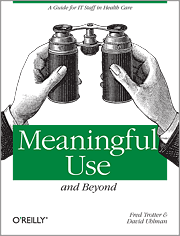
For the uninformed, meaningful use is the new regulatory framework from the Office of the National Coordinator of Health Information Technology (ONC) that determines how doctors will get paid for using electronic health records (EHR). If you’re in health care you need to understand meaningful use.
While Meaningful Use and Beyond was written with the IT professional in mind, it opened my eyes to a few things. Beyond the disturbing fact that my new EMR (EPIC) is built on language called MUMPS, here are a few pearls that I pulled away:
Why we need to let go of paper: “Paper is an excellent record of clinical care, to the degree that the data does not need to move. It is a perfect healthcare record to the degree that healthcare is provided by a single clinician, looking at a patient chart and the patient all at the same time. Modern healthcare is no longer a one-doctor, one-record, one-patient game. The coordination of care for a patient requires that critical information be moved from where it is to where it needs to be, on time. Sometimes the paper chart moves fast enough. Most of the time it does not.”
A medical record is a token of workflow: “This is an important insight that merits highlighting: even the paper chart is not just a paper record of a patient’s healthcare history and current status. It is also a token in a clinical workflow. Considering the record without considering the workflow is a simple mistake that is easy for technologists to repeatedly make. To prevent this mental error, try to adjust your mental imagery of a paper chart into something dynamic and moveable in nature.”
EMR is not an electronic paper record: “Being arrogant is the first rookie mistake in deploying health IT software. The second rookie mistake in deploying health IT systems is to attempt to replicate the patient chart in software. Ironically, this mistake comes from giving too much respect to the paper form. This is a frequent mistake made by computer programmers and purchasers who come to recognize the complexities of an effective paper-based workflow. They make the reasonable assumption that if they perfectly replicate a paper form in the health IT software, then they cannot fail to successfully replicate the nuances of that workflow.”
It goes on for 13 almost action-filled chapters covering topics such as the bandwidth of paper, patient facing software, human error, and the quantified self. My fav chapter title: ‘Herding Cats.’ E-patient Dave has a cameo with a discussion of his Beth Israel Deaconess / Google Health kerfuffle. Doctors should skip chapter 2, “The Anatomy of a Medical Practice,” as well as the latter chapters on interoperability and open source systems. The chapters on human error and personal health records are nothing short of gold. I’ll put chapters 1 and 4-9 as critical reading for every medical student and physician.
Meaningful Use and Beyond is a concise, easy-to-read primer penned by two of Health IT’s biggest thinkers. Perhaps most importantly Trotter and Ulren’s book has shown me that all of this is a work-in-progress. Quoting IT physician Dr. Ignacio Valdes, “For decades, doctors had no idea what they wanted, and software developers have given it to them.” We as physicians need to work together with our IT partners to create the tools that capture our workflow. Understanding the concepts spelled out in this book is a good start.
Links to Meaningful Use and Beyond are Amazon affiliate links.